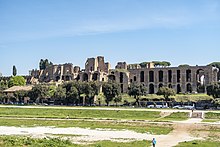Palatine Hill (Rome)

The Palatine Hill ( Latin mons Palatinus , Italian (colle) Palatino ) is one of the seven hills of Rome and is considered the oldest inhabited part of the city. Already in the 10th century BC BC human settlements were found on the Palatine.
Surname
The name of this hill was known as Palatium rather than Mons Palatinus until late antiquity , while in the Middle Ages it was referred to as il Palazzo Maggiore . The name Palatin (us) or mons Palatinus has only appeared since the Renaissance .
The imperial palaces on the Palatine Hill jointly bore the name palatium , from which the Italian term palazzo , the French palais , the English palace and the German palace developed . The word Palatinate as the seat of government of the German king or emperor comes from it, as well as the paladin , the archetype of the imperial palace guard.
geography
The Palatine is bordered by the Roman Forum in the north, the Velabrum valley and the Boarium forum in the west and the Circus Maximus valley in the south . On almost all sides - except in the northeast, where the higher ridge of the Velia is located - the hill drops steeply about 30 meters. Its height is about 51 m, while the total area on the ridge occupies about 10 hectares. Originally, the hill was divided by an east-west running depression into two flat peaks, the Palatine in the southeast and the Germalus in the northwest. The name Palatine extended to the whole hill as a general term. Four entrances lead to the Palatine: the Clivus Victoriae from the northwest and the Scalae Caci from the southwest as well as the Clivus Palatinus from the northeast and the Clivus Vestae from the north. Due to its conglomerate of natural rock and artificial walls, the Palatine appears like a cohesive unit.
history
According to the founding legend of Rome, the brothers Romulus and Remus conducted a bird's eye view to decide who should rule Rome, Romulus on the Palatine Hill, Remus on the Aventine . Since Romulus was proclaimed the winner, the Palatine is also considered the legendary place where the city was founded. In ancient Rome, on the Palatine Hill, as a holy place in the midst of the magnificent villas, there was still the poor hut called Casa Romuli , in which Romulus supposedly lived.
Since the 3rd and 2nd centuries BC Were built on the Palatine Temple. Remains of the temples of the Magna Mater ( Cybele ), Victoria and Apollon are still preserved today .
Since the end of the 2nd century BC BC (time of the Roman Republic ), the north-western area of the Palatine in particular became the residential area of wealthy Romans. These included many aristocrats, consuls, tribunes and speakers such as Cicero , Crassus , Gaius Octavius , Catullus and Publius Clodius Pulcher . The houses of the aristocratic upper class surpassed each other in luxury and splendor. The so-called House of Griffins , which was decorated with wall frescoes in the second Pompeian style, is of particular importance for Roman wall painting .
Many Roman emperors have resided here since Augustus established his residence on the Palatine Hill . Nero locked the Palatine in his golden house , which is buried under the ruins of the Trajan Baths . Today you can see, among other things, the oversized palace complex of Domitian with the Domus Flavia (government and representative building) and the Domus Augustana (residential building of the emperor).
When Constantine the Great moved the seat of government to Constantinople , palace buildings began to decline. Byzantine governors resided there for a while. Others became churches.
In the early Middle Ages, the family of the ancient Roman noble family of the Frangipani transformed the palaces into a fortress that extended to the Arch of Titus .
In the 16th century, the Palatine Hill was transformed into a park idyll. Wealthy families, like the Farnese , created the Farnesin Gardens among the ruins .
16 meters deep in the Palatine Hill, a cave decorated with shells and marble was discovered in November 2007. It is believed that this is the cave of Romulus and Remus .
literature
- Filippo Coarelli : Rome. An Archaeological Guide Extended and revised new edition. von Zabern, Mainz 2000, ISBN 3-8053-2685-8 , pp. 148-180, ( Guida archeologica di Roma. 1989).
- Filippo Coarelli: Palatium. Il Palatino dalle origini all'impero. Quasar, Rome 2012, ISBN 978-88-7140-478-3 .
- Adolf Hoffmann , Ulrike Wulf (ed.): The imperial palaces on the Palatine Hill in Rome. The center of the Roman world and its buildings (= Zabern's illustrated books on archeology . = Ancient world . Special issue. ). von Zabern, Mainz 2004, ISBN 3-8053-3325-0 .
- Ernest Nash : image dictionary on the topography of ancient Rome. 2 volumes. Wasmuth, Tübingen 1961.
- Patrizio Pensabene, Claudia Angelelli (ed.): Scavi del Palatino. Volume 1: L'area sud-occidentale del Palatino tra l'étà protostorico e il IV secolo AC Scavi e materiali della struttura ipogea sotto la cella del tempio della Vittoria (= Studi Miscellanei. 32, ZDB -ID 1133203-7 ). "L'Erma" di Bretschneider, Rome 2001.
- Aloys Winterling : Aula Caesaris. Studies on the institutionalization of the Roman imperial court in the period from Augustus to Commodus (31 BC - 192 AD). Oldenbourg, Munich 1999, ISBN 3-486-56195-2 (also: Munich, University, habilitation thesis, 1992).
Web links
Individual evidence
- ↑ Researchers claim to have found the cave of Romulus and Remus . In: www.spiegel.de , November 20, 2007.
Coordinates: 41 ° 53 ' N , 12 ° 29' E


